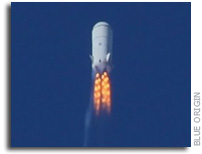Back when I first starting researching new space, there was one company a bit in the shadows. Just finding an official spokesman for the firm beyond the usual press release mass emailer was difficult. Word was it was deliberate. For some reason, Blue Origin, created by Amazon co-founder Jeff Bezos, had acquired a reputation for secrecy. There were unsubstantiated rumors going around that they’d lost an unmanned test vehicle early on.
Deserved or not at the time, it appears the company has become more transparent. Blue Origin has a test facility near Van Horne, Texas. Which I assure you is quite remote — I used to have to drive through the region on the way to a rock-climbing area called Hueco Tanks many years and pounds ago. It appears Blue Origin had a test vehicle fail near the Van Horne facility last week, and to their credit they’ve been pretty upfront about it:

Image provided by Blue Origin, said to have been taken in August right before the malfunction. Click for mkore info from Space.com
After the crash was reported Friday afternoon on The Wall Street Journal’s Web site, Mr. Bezos acknowledged the failure on the Web site of his space company, Blue Origin. The vehicle reached an altitude of 45,000 feet and a speed of 1.2 times the speed of sound before a “flight instability” occurred. “Not the outcome any of us wanted,” Mr. Bezos wrote, “but we’re signed up for this to be hard, and the Blue Origin team is doing an outstanding job. We’re already working on our next development vehicle.”
The vehicle was reportedly part of the New Shepard project, a propulsion system to compete in the upcoming commercial suborbital spaceflight field which takes off and lands vertically (The picture was made available by the company). I am working every double-secret-on-probation source to get more detail on this. Maybe there’ll be some news mid-week.

Fascinating fireball effects in the exhaust from that BO rocket – I can’t recall NASA machines ever producing anything similar.
Any of you rocketeers out there willing to hazard a guess on whether that indicates incomplete/delayed fuel combustion problems or other clues about the impending “flight instability”?
Pierce that’s an astute observation. I thought combustian instability when I saw that, but for all I know the thing is supposed to operate that way. Trying to find out more and score a scoop, we’ll see.
Update: Possibly shock diamonds?
Shock waves at the flame front normally have a distinct periodicity. Many pictures of high speed jet aircraft show a similar pattern.
More importantly, and with historical precedent as backup, failures such as this one are educational. I’d bet against two in a row.
Science: nine parts certainty, one part not.
Darksyde @ # 2: Possibly shock diamonds?
From the linked wiki stub:
Which in itself explains nothing. Though having no claim to rocket-scientist status myself, I strongly suspect that, unless the pressure of gases exiting the nozzle exceeds ambient air pressure, that there “rocket” won’t go nowhere, fast.
(Correction: if ambient air pressure significantly exceeds nozzle pressure, possibly the rocket will go in reverse.)
I asked an engineer who works in the feild and that’s what he told me, two words, shock diamonds. Didn’t say anything else. I’m trying to get the skinney on this though.